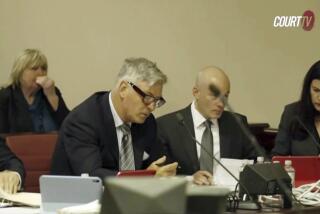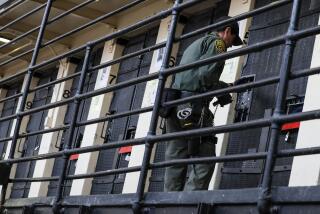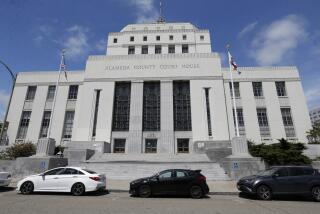Jurorsâ Race a Key Factor for Simpson Case Lawyers
As potential jurors trudged through the Santa Monica courthouse last week for the start of jury selection in O.J. Simpsonâs civil trial, defense attorney Robert C. Baker served notice that he was monitoring the candidates for more than bias.
Baker emphasized that he will scrutinize the âdemographicsâ of the 400 citizens expected to respond to the courtâs summons. If he is not satisfied, he told the judge, he âmay wellâ challenge the makeup of the jury pool.
He did not elaborate. He did not need to.
For although the prospective jurors who arrived last week certainly seemed diverse in age, ethnicity and experience--from a middle-aged black man who was studying a book of stock-trading tips to a white college student who fretted about missing beach volleyball practice--statistics show that the Santa Monica jury pool is fairly homogeneous. For starters, itâs 79% white.
âWhat I think of,â said jury consultant Noelle Nelson, who often works with Westside panels, âis yuppie baby boomers.â
Given the sharply different opinions that blacks and whites express about the Simpson trial, analysts say, Baker has every reason to be concerned about the Santa Monica pool.
A countywide Times poll taken shortly after Simpson was acquitted of criminal charges last October found that almost half of white residents--but only 4% of blacks--described themselves as angry at the acquittals. Two out of three whites said they thought Simpson was guilty of the slayings of Nicole Brown Simpson and Ronald Goldman, contrasted with just 13% of blacks. And blacks were much more receptive to the defense theory of a police frame-up.
âLike no other, this case created a split between blacks and whites,â said jury researcher Elizabeth Loftus, a psychology professor at the University of Washington. âRace is still going to be a key demographic in the civil trial.â
That dynamic was visible in the first few days of jury selection, which featured a significant number of black panelists. Six of the nine blacks questioned Friday indicated they were sympathetic toward Simpson, or at least to the theories of police conspiracy, ineptitude, frame-up and racism that his defense lawyers raised in the criminal case. A few of the whites grilled under oath expressed views that leaned heavily toward the plaintiffs, including distress about domestic violence in the Simpsonsâ relationship.
Baker clearly noticed the racial divide. At one point, he protested to the judge that the plaintiffs âhave made four motions to challenge [jurors as biased], all against blacks.â The judge dismissed his complaint and continued the process; by the end of the day, he had dismissed five blacks and three whites.
As in all trials, jurors for the Simpson case have been selected from Department of Motor Vehicles and voter registration lists. Although Santa Monica draws jurors from within a 20-mile radius of the courthouse, including neighborhoods with large minority populations in South-Central Los Angeles as well as exclusive beach communities like Palos Verdes Estates, court statistics show that only 7% of the pool is black. In contrast, the jury that pronounced Simpson not guilty in last yearâs criminal trial came from the downtown district, which is 30% white, 31% black and 29% Latino.
But attorneys who have tried cases in Santa Monica say that the raw census data donât tell the whole story.
The white, wealthy professionals typically associated with Santa Monica juries may not be willing to abandon their jobs for a $5-a-day civic duty that could drag on into next year. Those who do end up serving may not automatically sympathize with the relatives of Nicole Simpson and Goldman, who are suing for financial compensation.
âI would not think of Santa Monica as having a particularly good plaintiffsâ jury,â said Tom Dempsey, a consumer attorney who has handled many personal-injury cases there. Santa Monica jurors tend to be skeptical of victims who bring their hard luck to court, he said. âTheyâre tough on establishing liability--tougher than others.â
Other lawyers used the term âmixed bagâ when referring to the Santa Monica pool, noting that many retirees and students show up on the panels, as do middle-aged professionals. Overall, they said, Westside jurors tend to be better-educated than their counterparts in other courts. And although they may be more liberal on social issues, their white-collar business bent tends to nudge them toward conservative judgments when it comes to financial matters--including assessing damage awards in civil cases, attorney Deborah David said.
Jury consultants believe the defense will be able to find jurors favorably disposed to Simpson in Santa Monica--though they differ on how to identify them.
One consultant urged the defense to go for Ross Perot backers, on the theory that voters with a gritty independent streak might be inclined to support Simpson even if their neighbors all think he got away with murder. Another advised the defense to seek out football fans who idolize Simpson as a Hall of Fame running back. Several recommended black females--the group that dominated the criminal-trial jury that acquitted Simpson.
The plaintiffs, meanwhile, know who theyâre going for. Attorney Michael Brewer, who represents Goldmanâs mother, said in an interview before a gag order was imposed that he would seek jurors âwho will be tough, critical, discerning about the evidence.â
Ordinarily, plaintiffsâ lawyers try to steer away from hard-nosed business types such as bankers and managers, because they rarely get far peddling their tales of injustice and victimization before conservative jurors. In the Simpson case, however, Brewer said that conventional wisdom would be âflipped around,â as the plaintiffsâ lawyers will welcome jurors with analytical, skeptical approaches, figuring they will value the scientific evidence and discard the defenseâs vague conspiracy theory.
In that case, the attorneys might have been cheered by some of the reading material that prospective panelists brought to court last week. Sprinkled in among the standard jury-room fare of fashion magazines and John Grisham thrillers were plenty of newspapers (no one on the criminal panel was a regular newspaper reader), a book on computers and one on circuit analysis, and at least one mathematics textbook. David said that in her experience, many âcomputer types and people in technology fieldsâ show up for jury duty in Santa Monica.
Even Superior Court Judge Hiroshi Fujisaki, who has worked in Santa Monica for years, seems to expect the jurors he swears in to be scientifically literate; he recently expressed confidence that panelists will be able to distinguish between two types of blood tests since âanyone with high school or college chemistry or qualitative analysis would understand the difference.â
To find the 12 jurors and eight alternates who will serve on the Simpson case, the court has set up a three-step screening process.
First, prospective jurors who claim hardship can ask to be excused. But the judge has so far taken a hard line, releasing only those with major financial, medical or family burdens. The rest must move on to the next stage, which probes their exposure to publicity about the case. Those who survive that process will face a third set of written and oral questions about their attitudes toward domestic violence, racism, police misconduct and other relevant topics.
Every stage will be complicated by what jury consultant David Graeven calls âthe Rodney King-O.J. Simpson phenomenonâ--the possibility that citizens are trying to lie their way onto the jury to grab their 15 seconds of fame. âOne of the curiosities about these famous trials is that your groupie group wants to serve on them,â said Graeven, president of Trial Behavior Consulting in San Francisco.
Of course, the Simpson case also elicits the opposite reaction. Prospective jurors tried all sorts of excuses to win a dismissal based on hardship.
It falls to the lawyers and judge to determine if the candidates have personal agendas or are exaggerating to either stay on or get off the panel.
âOf all the cases Iâve ever heard of, this is most difficult,â USC law professor Erwin Chemerinsky said. Statistics and surveys, consultants and case studies can only go so far, he noted, because in the end, âyouâre trying to gauge something thatâs very unscientific--that is to say, sincerity.â
More to Read
Sign up for Essential California
The most important California stories and recommendations in your inbox every morning.
You may occasionally receive promotional content from the Los Angeles Times.










